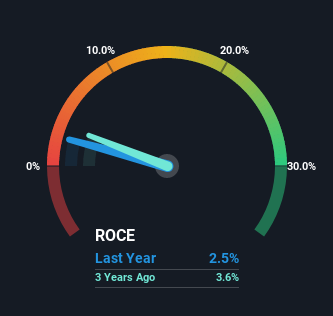- Hong Kong
- /
- Construction
- /
- SEHK:586
Investors Could Be Concerned With China Conch Venture Holdings' (HKG:586) Returns On Capital

If we want to find a potential multi-bagger, often there are underlying trends that can provide clues. Firstly, we'd want to identify a growing return on capital employed (ROCE) and then alongside that, an ever-increasing base of capital employed. If you see this, it typically means it's a company with a great business model and plenty of profitable reinvestment opportunities. Having said that, from a first glance at China Conch Venture Holdings (HKG:586) we aren't jumping out of our chairs at how returns are trending, but let's have a deeper look.
Return On Capital Employed (ROCE): What Is It?
For those who don't know, ROCE is a measure of a company's yearly pre-tax profit (its return), relative to the capital employed in the business. Analysts use this formula to calculate it for China Conch Venture Holdings:
Return on Capital Employed = Earnings Before Interest and Tax (EBIT) ÷ (Total Assets - Current Liabilities)
0.025 = CN¥1.6b ÷ (CN¥72b - CN¥7.6b) (Based on the trailing twelve months to June 2022).
So, China Conch Venture Holdings has an ROCE of 2.5%. In absolute terms, that's a low return and it also under-performs the Construction industry average of 6.9%.
See our latest analysis for China Conch Venture Holdings

In the above chart we have measured China Conch Venture Holdings' prior ROCE against its prior performance, but the future is arguably more important. If you'd like to see what analysts are forecasting going forward, you should check out our free report for China Conch Venture Holdings.
What Does the ROCE Trend For China Conch Venture Holdings Tell Us?
In terms of China Conch Venture Holdings' historical ROCE movements, the trend isn't fantastic. Over the last five years, returns on capital have decreased to 2.5% from 3.7% five years ago. On the other hand, the company has been employing more capital without a corresponding improvement in sales in the last year, which could suggest these investments are longer term plays. It's worth keeping an eye on the company's earnings from here on to see if these investments do end up contributing to the bottom line.
Our Take On China Conch Venture Holdings' ROCE
In summary, China Conch Venture Holdings is reinvesting funds back into the business for growth but unfortunately it looks like sales haven't increased much just yet. Although the market must be expecting these trends to improve because the stock has gained 72% over the last five years. However, unless these underlying trends turn more positive, we wouldn't get our hopes up too high.
On a final note, we've found 1 warning sign for China Conch Venture Holdings that we think you should be aware of.
For those who like to invest in solid companies, check out this free list of companies with solid balance sheets and high returns on equity.
New: AI Stock Screener & Alerts
Our new AI Stock Screener scans the market every day to uncover opportunities.
• Dividend Powerhouses (3%+ Yield)
• Undervalued Small Caps with Insider Buying
• High growth Tech and AI Companies
Or build your own from over 50 metrics.
Have feedback on this article? Concerned about the content? Get in touch with us directly. Alternatively, email editorial-team (at) simplywallst.com.
This article by Simply Wall St is general in nature. We provide commentary based on historical data and analyst forecasts only using an unbiased methodology and our articles are not intended to be financial advice. It does not constitute a recommendation to buy or sell any stock, and does not take account of your objectives, or your financial situation. We aim to bring you long-term focused analysis driven by fundamental data. Note that our analysis may not factor in the latest price-sensitive company announcements or qualitative material. Simply Wall St has no position in any stocks mentioned.
About SEHK:586
China Conch Venture Holdings
An investment holding company, provides various solutions for energy conservation and environmental protection in Mainland China and the Asia-Pacific.
Fair value second-rate dividend payer.
Market Insights
Community Narratives



